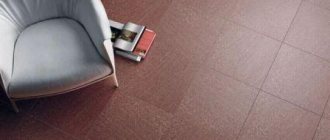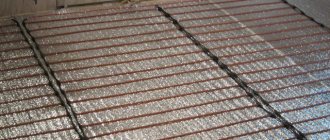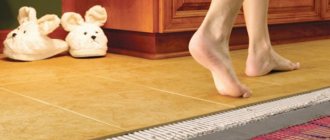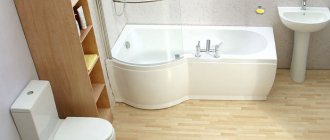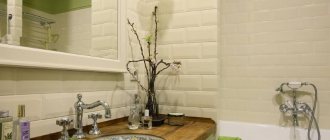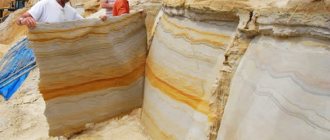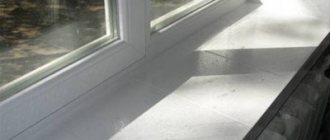06/02/2018 Read in 3 minutes.
Porcelain tiles in a modern interior are not only a new fashion trend, but also reliability and durability of the floor covering, high wear resistance and durability and, of course, visual appeal. To understand where it is best to use it, you need to understand all the advantages and disadvantages that the material has in general, and also take into account the peculiarities of its use in certain parts of the house, and also understand whether all the advantages of porcelain stoneware will always be appropriate for a specific room and, if possible smooth out the imperfections of the material.
No. 1. What is porcelain tile?
Porcelain stoneware is a very strong and durable type of facing covering, which can rightfully be considered a substitute for natural stone. The composition of porcelain stoneware includes such natural components as clay, mica, sand and feldspar, and a special additive in the form of granite chips gives this material special strength.
Porcelain stoneware is produced by pressing and sintering. All components are mixed together in the required proportions, pressed at a pressure of 400-500 kg/cm², and then subjected to high-temperature annealing in an oven (1200-1300°C). Using this technology, it was possible to achieve the absence of pores in the finished material and its high strength.
At first, porcelain stoneware was used as a floor covering in industrial premises with high loads; now technology has stepped far forward, which has made it possible to use porcelain stoneware not only as a floor covering in residential premises, but also for finishing walls and facades. We will look in more detail at those types of porcelain stoneware that are used specifically as flooring.
Advantages of porcelain tiles
- High strength. As noted above, porcelain stoneware is a particularly durable material. Its strength, if the correct laying technique is followed, remains up to 200 kg/cm2, with any thickness of the tile. It is quite difficult to damage it during everyday use. The tiles can withstand significant static and shock loads. Doesn't crack when impacted. As a rule, porcelain stoneware material receives any damage during transportation, unloading, loading, or at the stage of repair work.
- Does not fade when exposed to sunlight. Does not change its texture and pattern over time.
- Resistant to any contamination. Due to its dense structure, it does not absorb third-party liquids or fats. Therefore, all dirt can be easily removed with a regular wet cloth or some detergent.
- Porcelain stoneware material is particularly water-resistant, since porcelain stoneware is not porous. Does not absorb moisture Thanks to these properties, porcelain tiles are a good material for finishing tiles in rooms with high humidity, such as bathrooms, restrooms and kitchens.
Porcelain tiles are suitable for wet spots in the house 5. Resistant to acids. Does not change color, surface, or properties when any chemicals or acids come into contact with the surface. After removing such liquids, there will be no unsightly marks on the surface of the porcelain tiles.
6. Abrasion resistance. The pattern and texture of porcelain tiles are not completely erased, since the coloring pigment penetrates the entire thickness of the tile. With this design, even damage to the slab in the form of small potholes will not be noticeable.
7.Environmentally friendly. The material consists of natural components, without chemical impurities. 8. Fireproof, because it does not burn and does not support combustion under the influence of open flame. In addition, when exposed to high temperatures, it does not emit any harmful fumes. 9.Variety. Porcelain tiles come in a wide range of colors, patterns and shapes. There are also many varieties of tiles depending on the type of surface material and processing. These are porcelain tiles with a matte surface, polished, glazed surface, technical and structural porcelain tiles, satin. At the same time, varieties of porcelain tiles are constantly updated. The manufacturer is constantly improving porcelain stoneware material and updating its variety. With the help of porcelain tiles, you can realize all your design fantasies.
No. 2. Advantages of porcelain stoneware
The main advantages of porcelain stoneware:
- Environmentally friendly thanks to the use of natural ingredients.
- Low water absorption coefficient . Due to the almost complete absence of pores, porcelain stoneware does not absorb water, which makes it frost-resistant. Also, the absence of pores allows you to not be afraid that the adhesive mixture will seep onto the surface of the tile and ruin it, as sometimes happens with tiles.
- Chemical resistance, be it alkali or another acid, which makes it possible to clean it with absolutely any means.
- Wear resistance and high bending strength . Porcelain stoneware is such a durable material that it has a very high bending strength per m², which makes it possible to lay it even on uneven surfaces.
- Resistance to mechanical stress . The glossy surface of porcelain tiles does not lose its shine and is scratch resistant for many years.
- Color constancy . Porcelain stoneware is absolutely not affected by ultraviolet radiation, which allows it to maintain the clarity of the pattern and the brightness of the color even with prolonged exposure to the sun.
- Anti-slip coating . There is a matte, slightly rough variety of porcelain stoneware that will remain non-slip even when wet.
- Thermal conductivity . This material does not allow cold to pass through and retains heat well.
Advantages of porcelain stoneware in the interior
Of course, this material, which is increasingly attracting the attention of designers, specialists in the construction industry and ordinary people who have started renovating an apartment or house, has a number of undeniable advantages, among which the following are worth noting:
- An artificial material that is not subject to age-related changes always retains its shape, the appearance and service life of such a coating will be significantly longer than that of other flooring materials;
- Porcelain tiles are an environmentally friendly coating. You can verify this by looking at the composition, which includes clay, quartz sand, kaolin and spar;
- The strength of such a floor covering is not in dispute; it is resistant to frost, moisture and can withstand heavy loads;
- Porcelain tiles do not require any special care, they are indifferent to the harmful effects of chemicals and can be easily cleaned with simple wet cleaning;
- The variety in the choice of porcelain stoneware flooring is impressive and not only different colors, but also textures.
view the album in a new window
In the photo: Interior of a living room in a classic style apartment
No. 3. Types of porcelain stoneware
The following types of porcelain stoneware are most suitable for flooring:
- Technical porcelain stoneware An ideal option for covering floors in industrial premises.
- Matte porcelain stoneware This type of porcelain tile does not lend itself to any additional changes after undergoing a heat treatment cycle. This makes its surface a little rough and discreet. But it has increased hardness and anti-slip properties.
- Polished porcelain stoneware A more capricious appearance than the previous one, it has a smooth, even surface, almost mirror-like, thanks to processing with abrasives. This treatment somewhat reduces its wear resistance. For a longer service life, it must be treated with special mastics, which create an additional protective layer on its surface. Otherwise, with prolonged use, polished porcelain tiles will gradually turn matte.
- Satin. This porcelain tile has an unobtrusive light shine, which is obtained by applying mineral salts to the surface before baking in the oven. This type of treatment does not affect wear resistance.
- Structured The type of porcelain tile has a relief surface, allowing you to imitate the texture of wood (parquet porcelain tile), leather or various types of stone. Visually and to the touch it is practically no different from natural materials.
- Glazed porcelain stoneware is produced by applying a special glaze to the surface and then firing it. The glazed surface is much stronger than conventional ceramic tiles, however, this type of porcelain tile is not recommended for use in rooms with high traffic and a high level of mechanical stress. Over time, it loses its visual appeal.
- Lapped Porcelain stoneware has a mixed texture - half polished, half matte. This effect is achieved by removing a thin, uneven top layer using special polishing stones. This type can be safely used for flooring in rooms with high traffic and high loads.
- Double backfill. The top layer of the tile, approximately 3 mm, is made from the components of the required colors, and the bottom layer is made from the main components. In this way, bright, colored tiles are obtained, the wear resistance of which remains at a high level.
Finishing
A simple white or beige tiled splashback will transform a Provence-style kitchen.
Clinker tiles are a popular trend in the interior. It creates the effect of old or fresh brickwork. This solution makes the design elegant.
Tiles with photo printing - this material allows you to see almost any desired image on the surface. The design and glaze coating remain bright and fresh for a long time. The space takes on an exclusive design.
No. 4. Classification of porcelain stoneware
- Size. The most popular sizes of tiles for flooring are square tiles with dimensions of 300x300 mm, 450x450 mm and 600x600 mm. If you have some kind of designer and unusual project in mind, and the floor will be the center of your interior, then you also have at your disposal tiles of the smallest size - 50x50 mm, and non-standard sizes - 200x200 mm, 150x300 mm, 300×450 mm, 300×600 mm, 400×400 mm. If you still haven't found the right size for you, you can get it using waterjet cutting .
- Caliber is the amount of permissible discrepancy in the size of the tiles, which is 3-5 mm. During the heat treatment, the edges of the tiles are slightly deformed, so they may differ from each other. To avoid large discrepancies in size, the tiles undergo a process of rectification , that is, trimming the edges using special equipment. match perfectly during subsequent installation .
- Thickness. The maximum thickness of porcelain stoneware is 30 mm, the minimum is 3 mm. With proper installation of a 3 mm thick floor covering, its strength and wear resistance are in no way inferior to a 30 mm thick covering, so there is no point in giving preference to the thickest, and therefore more expensive, porcelain stoneware. For example, recommended specifically for flooring, 8.5 mm , can withstand a load of 200 kg/cm2.
Abrasion class. Abrasion (wear resistance) is the main technical characteristic of porcelain stoneware. Depending on the degree of load and mechanical impact, there are 5 main classes of abrasion:
- PEI I, PEI II – for rooms with low traffic in soft shoes (bathroom, toilet);
- PEI III - for residential premises with an average level of traffic, without access from the street or yard (balcony, kitchen, hallway);
- PEI IV – for public spaces with high traffic levels;
- PEI V – for premises with any level of traffic and mechanical impact.
For example, for the floor covering in the entire apartment, abrasion class III is quite sufficient, and for the bathtub and toilet, class I or II can be used. If your task is to choose porcelain tiles for a private home, then choose class IV for the hallway, and for the porch give preference to class V, which is also frost-resistant. In other rooms, class III will also be sufficient.
Polished or glazed tiles - what to choose
Before buying tiles, you need to know how these two types differ from each other.
Characteristics of polished tiles:
- gets dirty quickly;
- needs impregnation;
- porous surface makes cleaning difficult;
- not used in bathrooms and kitchens;
- elegant, delicate material.
Characteristics of glazed:
- a smooth surface prevents dirt from accumulating;
- no impregnation required;
- easier to wash and vacuum;
- can be installed in the kitchen and bathroom.
When choosing, you should remember not only aesthetics, but also the functionality and durability of the material.
Polished
Glazed
No. 5. Are porcelain tiles and tiles the same thing?
Many people mistakenly believe that these are really the same type of flooring, they just decided to shorten the name and raise the cost... But this is far from the case. differences significant ones at that :
- Porcelain stoneware undergoes heat treatment at significantly higher temperatures than tiles, which explains its higher strength and wear resistance .
- Due to high temperatures, the components of porcelain stoneware literally melt during processing, which completely eliminates the appearance of micropores . This prevents moisture from entering the internal structure, so porcelain stoneware can withstand high sub-zero temperatures without cracking. Tile has a porous structure and cannot withstand large temperature changes.
- Porcelain tiles are easy to clean - due to the absence of micropores, the surface becomes less dirty. A damp cleaning is enough to maintain its beautiful appearance.
- Porcelain tiles are absolutely resistant to any chemicals . This makes the cleaning process easier. Tile does not tolerate aggressive substances well and can lose its shine when exposed to, for example, alkali.
- Cracks and chips do not form on the surface of porcelain stoneware, even after a long time . Despite the fact that on tiles you can observe microcracks on the surface after just a couple of years of use.
- Porcelain tiles, due to their resistance to ultraviolet radiation , will not lose their color and clarity of design even after 50 years, which cannot be said about tiles, which fade over time.
- practically no stains . Have you noticed that when laying tiles, the adhesive mixture sometimes appears on the surface and has to be changed, since this is an irreversible process? This will never happen with porcelain stoneware due to its monolithic structure . Even if you spill a coloring substance on the surface of porcelain stoneware, it can be easily removed without leaving a trace.
- Porcelain stoneware has a high bending resistance , which allows it to be laid even on uneven surfaces. The tile breaks at the slightest distortion.
- The best porcelain tiles have absolutely smooth and clear edges, which allows you to perform seamless styling.
Tile layout programs
To better imagine the future interior, see the layout and calculate material consumption, you can use one of the special computer programs. This will help you avoid mistakes when calculating the quantity and cost of material, as well as disappointments due to the fact that the selected tiles in your room do not look as planned.
No. 6. Application area
Due to the variety of colors and textures and their constancy, resistance to mechanical damage and chemicals, frost resistance and bending resistance, porcelain stoneware is used for cladding walls and floors both indoors and outdoors . Due to its high levels of hardness and abrasion, this is an ideal type of coating for industrial and public spaces. It will also be used for finishing halls, swimming pools, floors in cafes and even at train stations. After all, this material is truly eternal, and the ability to produce in various sizes makes it almost universal . Whatever room comes to your mind, you can always choose the necessary type of porcelain stoneware. Porcelain tiles even replaced parquet! Both visually and to the touch it does not differ at all from natural wood.
How to choose
When choosing glazed porcelain tiles, the following parameters should be taken into account:
- texture;
- degree of water absorption;
- adaptation to the specifics of the room;
- weather resistance;
- size;
- colors.
Which texture to choose
Regardless of the color of porcelain stoneware, you need to pay attention to its texture. This determines how slippery the surface will be and whether dirt will accumulate on it.
To make the tiles look elegant, it is better to choose polished ones, reminiscent of marble. If you need a rough texture to make the floor less slippery, a material with a matte finish is a good option. However, it is much more difficult to clean.
No. 7. Disadvantages of porcelain stoneware
Despite a number of significant advantages, like any material, porcelain stoneware also has disadvantages
- Porcelain tiles are able to prevent the penetration of cold and retain heat, but this material itself is cold , just like tiles. The solution is to use heated floors.
- All types of porcelain tiles, except technical, matte and structured, will be slippery .
- Of course it is worth noting high price porcelain tiles compared to tiles. But in this case you can bet, because it’s better to spend once and get coverage with a guarantee of 50 years or morethan constantly replacing cracked or faded tiles. Moreover, there are now many types of porcelain tiles available from different manufacturers with different pricing policies. The highest price is for Italian porcelain stoneware, but there are also Belarusian, Turkish, Greek and Baltic ones, which allows you to select the material with the best price-quality ratio.
User reviews
Our kitchen, living room and hallway are lined with the same ceramic granite, we have been using it for 6 months. It was cold in winter, the heated floor was always turned on. Now in the summer it’s even nice for my feet to be on the cool floor; I always just walk barefoot. From the comments - we laid a light floor, everything is visible on it! And it’s better not to drop dishes on it.
Ivan, Magnitogorsk
We have porcelain tiles in the hallway and kitchen. I practically don’t use heated floors under it, maybe in cold weather I’ll turn it on, of course, it’s quite warm (as far as this word is applicable for such a surface) even without warming up with a heated floor, it’s pleasant to walk on. It differs from tiles in thickness and resistance to breaking, so lay it and don’t hesitate!
Maria, Moscow
I visited where the entire apartment, except for the bedrooms, was made of porcelain stoneware with partial heated floors.
I really liked the feeling of bare feet on the comfortable tiles and it doesn’t bother me visually at all (but there is such a sharp contrast on the floor in the bathroom and bedrooms in winter compared to the rest of the apartment). We will also install porcelain tiles in the hallway, living room, kitchen, loggia and bathroom, with heated floors, and in the bedroom there is a warm cork floor without heating. Mikhail, Novgorod
No. 8. What should you pay attention to when purchasing?
- Before purchasing, you need to already know what size tiles you want . This way you can easily figure out their quantity by dividing the desired coverage area by the area of one tile.
- Please note that all tiles match in color and shade . All tiles must be from the same batch, otherwise the difference in shade will be very noticeable after installation!
- The caliber of all tiles should also be the same - this will ensure a beautiful, uniform installation without visible differences in size.
- Be sure to check the weight ! The recommended tiles for flooring are 8-8.5 mm thick and weigh at least 18.5 kg. Do not hesitate to clarify this point, otherwise you risk buying a fake!
- The back side of the tile can also say a lot. It should have shallow, small squares with sides of a maximum of 2x2 cm. The larger and deeper these technical notches are, the lower the quality of the material.
- Do not forget about the reserve , which should be 10% of the total number of tiles for the diagonal laying method and 5% for other methods.
- The packaging of porcelain tiles for flooring will show foot on a black background, if this sign is repeated, it means a higher wear resistance class. If you see snowflake - This is a frost-resistant porcelain stoneware.
Differences from other types of facade tiles
Porcelain tile cladding has two main competitors - natural stone and ceramic tiles (regular, clinker, terracotta). When comparing a product with a natural analogue, the first thing I would like to note is the more favorable price of the artificial material.
As already mentioned, porcelain stoneware costs much less than natural stone, but its properties are practically not inferior to it . Moreover, the strength of the artificial material is superior to its natural counterpart.
Another point is the appearance of the products.
Porcelain tiles compete with such types as:
- ceramic;
- clinker;
- basement;
- under a stone;
- under brick;
- basement
IMPORTANT!
Natural stone is formed in nature, so blocks can have different shades and different numbers of veins. The texture and color of porcelain stoneware are controlled in production, which makes it possible to obtain more identical samples.
When comparing porcelain tiles with ceramics, there is nothing to say about the superiority of the former in terms of strength - it is indisputable. There is a significant difference between analogues in the level of water absorption: in the first case this figure is up to 0.5%, in the second – up to 10% .
Hence the conclusion - porcelain stoneware is much better suited for façade cladding than ceramics. True, the latter also has a noticeable advantage - due to its higher porosity, it weighs less than ceramic granite.
No. 9. Features of laying porcelain stoneware
If you decide to refuse the expensive services of professionals and decide to install porcelain stoneware yourself , you should approach this issue very carefully, because the durability of the coating will depend on the correct installation.
Porcelain stoneware, as a very durable material, is very difficult to cut, so that you do not have any difficulties or surprises during the installation process, prepare all the necessary tools :
- You will definitely need a tile cutter or grinder
- Required building level
- A spatula with a smooth edge is for applying the adhesive mixture and a spatula with a serrated edge is for removing excess mortar.
- A construction bucket or other convenient container for mixing the adhesive mixture
- Drill and special construction mixer to facilitate the mixing process
- Water container
- Rubber hammer
- Plastic crosses, which regulate the width of the seam, are chosen to your taste
Since porcelain stoneware is very heavy, it is necessary to choose a mixture that will withstand heavy loads. It is better to choose a plastic adhesive mixture with high “tenacity”; in addition, it prevents the tiles from falling off if your house is not yet fully settled and “walks” when temperatures change or the foundation settles. When the adhesive mixture is selected, move on to the next step.
Surface preparation
Although porcelain stoneware provides for differences of up to 15 mm, it is better to pre-level the surface by pouring concrete, pre-waterproofing, and then carefully prime it . If porcelain tiles are laid on a heated floor, then the sequence will be as follows - waterproofing the room, laying a heated floor, pouring concrete (screed), impregnating with soil, laying porcelain tiles. By the way, installation on old wooden floors is not allowed . After preparing the surface, you can proceed to the mixture. Stir the adhesive mixture according to the instructions on the package. If you are laying tiles for the first time, you should not mix the whole mixture at once, in case you will have difficulties in the process, and the mixture does not retain its adhesive properties for so long. It’s better to start by diluting a small amount, literally a couple of tiles, and try to lay them, thereby testing your capabilities.
Disadvantages of using porcelain stoneware in the interior
Like any flooring, porcelain stoneware has a number of disadvantages that you should know about in advance. And the top 5 shortcomings are as follows:
- It feels like a cold material, like any floor tile. This is especially true for those who like to walk around the house barefoot. Installing a warm electric floor can be a solution to the problem, but this will add additional energy costs. As for the installation of water heated floors, it is worth remembering that this requires additional approval from the relevant authorities.
- Porcelain stoneware is created artificially, so it does not have the characteristics of, for example, wooden floors, which with age acquire a special sophisticated look, as they say, “aging beautifully,” although many modern people would consider this a plus. Over time, glossy varieties of porcelain tiles acquire scratches and cracks, which cannot be restored in any way;
- When laying porcelain stoneware, it is impossible to avoid butt seams, and in any case they will be visible to the naked eye. Sometimes the interior does not allow such flashy details, and such flooring will not look appropriate. Also, small household debris, dust and dirt get clogged into small crevices;
- This flooring is hard, rigid and quite thick. How relevant this is, everyone decides for themselves, but let’s say, if you drop a mug or plate, phone or watch, most likely the thing will be broken on the surface. The thickness of the tiles for a space where every centimeter is important will eat up a lot of usable space;
- Porcelain stoneware is a fragile material when laid, just like tiles, so it is better to consider thicker products and contact professionals.
Facade mounting
There are several ways to fix tiles. They all require a completely different approach, which allows you to choose the most optimal option in a given case.
Fastening with clamps
This is the most common method of installing porcelain stoneware slabs, which is performed using special fasteners made of galvanized or stainless steel.
Stainless steel clasps are more resistant to dynamic loads, for example, wind.
This fastening method, in turn, is also divided into two types:
- Hidden fixation . The slabs are attached to a guide profile using clamps, which is pre-installed on the façade.
- Visible fixation . One of three types of clamps is used as fasteners: starting, ordinary or corner (the latter are rarely used). Special “whiskers” of the clamp grip the edges of the tile without violating its integrity. The disadvantage of this method is that the fasteners (antennae) remain visible. But there are also advantages - faster installation and lower material costs.
Glue mounting
For fixation, adhesives based on elastic polyurethanes are used. In this case, a special tape is used, which is applied to the slabs along with glue. The tape supports the cladding until the adhesive has fully set to the base.
NOTE!
There is also a combined option using an adhesive composition. In this case, the tile is glued to the profile and additionally fixed mechanically .
Collet mount
This is the most expensive fixation method. Cone-shaped holes are drilled into the tiles using special equipment. An anchor collet is inserted into the hole, which expands while rotating, providing a strong and reliable fastening.
Gres (ceramic granite) - characteristics
A special ceramic mass mixture, which includes clay, kaolin, quartz sand, feldspar and fireclay, is pressed under a pressure of about 800 kg/cm2 and then fired. At a temperature of 1200-1400 °C, a material with special chemical and mechanical properties is obtained. It is a hard, homogeneous material with very low porosity. The Italian word "grès" means that the ceramic mass has become vitrified in appearance, hence the unusual scratch resistance of porcelain stoneware.
The very finely ground ingredients melt during the firing process, providing extremely low water absorption - less than 0.5% of its own weight (for comparison, the water absorption of concrete should not be higher than 5%). Thanks to this, porcelain is frost-resistant and can be used outdoors. Its resistance to moisture also makes it ideal for kitchens and bathrooms.



